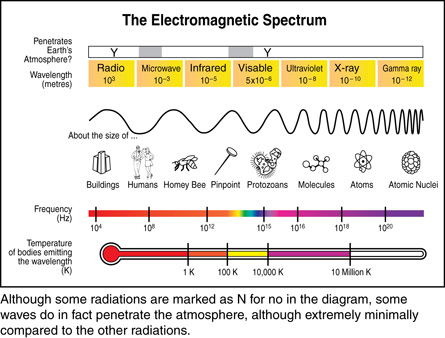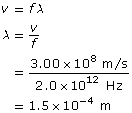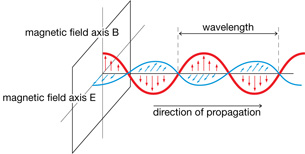Module 5
1. Module 5
1.4. Page 2
Module 5—Wave Theory of Light
 Explore
Explore

© Jip Fens/shutterstock
In scientific terms, electromagnetic radiation, or EMR, is radiant energy travelling outwards from a source in the form of a wave. Unlike the mechanical waves studied in your previous physics courses, EMR does not require a material medium in which to move. The EMR wave is classified by its wavelength (length) or by its frequency (oscillations per second). For example, when you turn on a light, microwave popcorn, use a cordless remote control, talk on a cellphone, or tune into a radio station, you are using devices that operate with different types of electromagnetic radiation based on their wavelengths and frequencies. Organizing all of the different types of electromagnetic radiation by frequency or wavelength produces an electromagnetic spectrum.
wavelength: the distance between adjacent points on a wave that vibrate in phase with one another (m)
frequency: the number of cycles per unit of time (Hz = 1 cycle/second)
electromagnetic spectrum: a general classification of all electromagnetic radiation based on wavelength, frequency, and energy

Adapted from image courtesy of NASA
The rainbow seen in the picture is a natural example of a spectrum. It demonstrates that white light can be separated into a “spectrum” of colours organized by wavelength. The violet light has a wavelength of 400–450 nm (nm is nanometer, ×10–9 m). As you look inward, the wavelengths get longer until you reach red light at 630–700 nm. Therefore, a rainbow is the natural expression of the visible light spectrum. But what is just beyond the violet end of the spectrum? What is just beyond the red end of the spectrum?
Obviously, these will be EMR waves that cannot be sensed by the human eye. Some, however, you may sense with our skin. Infrared waves, for example, are felt as heat; they have a wavelength slightly longer than red light, making them “invisible” (outside the visible spectrum). The term red hot may have more meaning for you now. Ultraviolet waves, for example, cause sunburns; they have a wavelength shorter than violet light, so they are also “invisible” (outside the visible spectrum). Even though you can’t see them they can still affect you.
 Read
Read
Read pages 637–638 in your textbook to find out more about the types of EMR and the electromagnetic spectrum.
 Self-Check
Self-Check
SC 1. Using “Table 13.1” on page 638 of your textbook, identify what is unique about visible light compared to the rest of the EMR spectrum.
SC 2. Open the Spectrum applet. Adjust the wavelength and frequency slider. Observe the energy of the wave. Describe the relationship between the following two characteristics:
- frequency and energy
- wavelength and energy
SC 3. An infrared wave of EMR has a frequency of 2.0×1012 Hz. What is the wavelength of the wave?
 Self-Check Answers
Self-Check Answers
Contact your teacher if your answers vary significantly from the answers provided here.
SC 1. The visible light part of the spectrum is unique because that is the only part of the electromagnetic spectrum that can be sensed by the human eye.
SC 2.
- The frequency and the energy of EMR are proportional; as the frequency doubles, the energy doubles.
- The wavelength and the energy of the EMR are inversely proportional. As the wavelength doubles, the energy halves; and as the wavelength decreases to one-third of its value, the energy triples.
SC 3.
Given

Required
the wavelength of the wave
Analysis and Solution

Paraphrase
The wavelength of the infrared wave is 1.5×10–4 m.
 Module 5: Lesson 1 Assignment
Module 5: Lesson 1 Assignment
Remember to submit your answers to A 1, A 2, A 3, and A 4 to your teacher as part of your Module 5: Lesson 1 Assignment.
A 1. Medical technologies related to imaging and cancer treatment use high-frequency EMR. What precautions should medical personnel take when working with these types of technologies?
A 2. A student measures the period of an electromagnetic wave as 3.64×10–15 s.
- What is the frequency of the wave?
- What is the wavelength of the wave?
- To which part of the electromagnetic spectrum does the wave belong?
A 3. What are the two competing models of electromagnetic radiation? Explain how each works.
A 4. Explain Young’s experiment and how it proved one of the theories of electromagnetic radiation.
 Try This—Maxwell’s Electromagnetic Theory, 1865
Try This—Maxwell’s Electromagnetic Theory, 1865
In 1865, James Clerk Maxwell summarized four basic relationships between electricity and magnetism that predicted the existence of an electromagnetic wave. The four relationships were described in mathematical notation beyond the scope of this course but are presented here as general textual descriptions.
- An electric field surrounds any charged object, and an electrostatic force will act on any other charged object that exists within it, exhibiting action at a distance.
- A magnetic field is a three-dimensional continuous closed loop.
- An electric current, or a changing electric field, will produce a magnetic field.
- A changing magnetic field can produce an electric field capable of causing an induced current and potential difference in a conductor within the field.
From these four relationships, two reverse phenomena exist. A changing magnetic field produces an electric field, and a changing electric field produces a magnetic field. Based on this knowledge, Maxwell was able to correctly predict that it is possible for changing magnetic and electric fields to travel through empty space in the form of an electromagnetic wave. His prediction also described other properties and characteristics of the electromagnetic wave. Specifically, he predicted the following:
- The electromagnetic wave consists of perpendicular, oscillating, electric, and magnetic fields in a constant phase relationship. The direction of propagation is perpendicular to both the magnetic and electric fields.

View the animation of a propagating electromagnetic wave. In this animation, an electromagnetic wave is produced whenever a charge is accelerated.